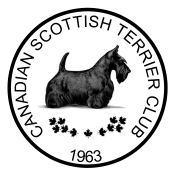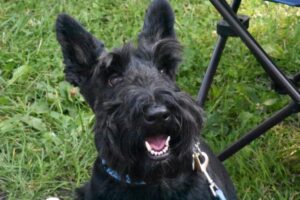By Kathy McAra
For years I have been asked, “How can you have such success training Scottish Terriers?”
The most important things that you have to remember when training this breed is Patience, Perseverance and Praise. If you remember this, half the battle is over. Also, you need to love Scotties and understand the breed for what it is.
I have had exceptional luck when it came to training Scottish Terriers. I was blessed with a wonderful Scottie named ‘Int. AC-Bronze & Can. Ch. Greatbear Thistles wee Paisley, CDX CG SHDCH FD VNAC VOJC VNGC CGC TT’. ‘Bonnie’ was motivated and had the intelligence to know when Scottie attitude was called for and when to put it on the shelf. She forgave my mistakes and inexperience and was always willing to learn something new. Bonnie was still earning titles in agility at the age of 10. My second blessing has come in the form of a Scottie named ‘Int. & Can Ch. Rynara’s Temperametal Lady, CD EAC EJC OGC’. ‘Temper’ is the 5 year old Scottie that I am currently working with and she has eleven titles with many more to come.
Lets start with just the basics
Choosing the puppy:
Look for that puppy in the whelping box that causes all the problems. The one that is always into trouble and making itself known. You may want to consider a bitch with slightly less bone for agility or flyball where speed is important.
Getting started: Start training as close to 8 weeks as possible. The puppy should be able to walk properly on a lead, come when called and sit by the time they are four to five months old. By six months most puppies can be comfortable using open tunnels, collapse tunnels, dog walks, and stepping over bar jumps that are flat on the ground. Puppies should not be encouraged to jump more than 4 inches until their shoulder fronts are set at approximately 1 year of age. If you can find a good puppy socialization class or puppy obedience class that comes highly recommended, go and watch for a several nights and see if that is what you want. In my view, if an instructor won’t let you watch, the class is not worth going to. Before puppies embark on any training outside of the home, shots are highly recommended – check with your veterinarian. Puppies also need to learn boundaries and respect for other breeds – socialization training aids with this. A well-socialized puppy is a joy to live with, one that is not, can be a real pain. To attain this, challenge your puppy to new and interesting experiences by taking him with you as many places as possible. When you start early with your training, you lay in the foundation work that will lead to a successful relationship between you and your training partner.
Equipment: There are several types of collars that can be used. Buckle collars and metal choke chains being the most popular. Every dog is different and you will have to use what you and your dog are comfortable with.
Motivations: FOOD!!! and PRAISE. When you work with your dog, you should be constantly talking and praising the dog while you work. The positive tone of your voice conveys more meaning to your dog than any other training aid.
Making training fun: That is the secret with Scotties. After practice it is time to chase a ball, play chase, or whatever they like to do for fun. Make sure that you play after every session.
Training tips: Scotties don’t seem to enjoy endless repetition. If you do it right the first time go on to something else. Scotties seems to reason that if they have to do it again, that they did something wrong the first time and so they change it for the second try. So quit while you are ahead. Don’t leave any of your training on a sour note; end on a positive one. Several short sessions a day are far better than one or two longer sessions
Sits and Downs: One of the hardest things for a Scottie to do is to stay in one place for any length of time. Start slow with 10 seconds working up to a 7-minute sit stay and a 10-minute down stay. After releasing the dog make sure that you offer lots of praise.
Recalls: When you leave the dog, go about 15 feet, turn and face the dog, and then call. When you see that the dog is starting to come, turn and run away in a straight line. When you have gone about 25 feet, stop and turn to face the dog. Ensure you are facing the dog before he reaches you. Make the dog sit squarely in front of you and give the dog a reward with plenty of praise.
Forging or lagging: Forging or racing ahead can be corrected with constant U-turns into the dog. The dog soon learns to stay at your side or they run into you. Lagging can be corrected with small well-timed pop corrections with your lead. A puppy soon realizes that if they don’t want the correction they will stay at your side. Practice your heeling often because it’s a key to successful trial work. Remember to always start with the left foot so the dog has chance to keep up with you.
Jumping: NO PROBLEM. Our guys love to jump, and any good class can teach you this. Start by having the bar or jump at its lowest position and jumping it with the dog. The two most common commands are “hup” or “jump”. Always give the command that you are going to use for jumping when they take off. When the dog is comfortable, leave the dog, tell him to stay, walk around the other side of the jump and call the dog to you over the jump. The next step is to approach the jump with the dog still on leash and as you get close to the jump, tell the dog “jump” as you run past the jump.
Signals: The Utility signals are best taught at the novice level. If you use them as well as verbal commands, the dogs learn to pay attention to you because they don’t know whether they will be given a verbal command or a hand signal.
Training: Do research on obedience instructors in your area. Go watch a few classes. There is no set way of doing things. What works well with one dog may produce problems with the next. Learn to be flexible. New methods of training are always coming on the scene. Right now the most popular method of training here in Calgary uses a clicker. I have just started using this method on a young puppy, so don’t feel that I can give any training advice from a personal view. However, it has been observed that it does seem to work well with most breeds. Before trials, polishing classes to brush up your skills are recommended.
In conclusion, I have just touched on a few of the basic things that I have found go into training a Scottie. Den-trials, flyball, scent hurdle racing and agility open up a whole new world of wonder for you and your Scot. Start small, basic obedience comes first. Everything that you learn in obedience can be used in anything else that you want to do with your Scottie. People are often in awe of Scotties in obedience, agility.. etcetera. We have an intelligent, loyal, curious breed that is willing to go anywhere and do anything. With your encouragement and support your Scottie can be a true ambassador for its breed.
Remember the key with our Scots is the three ‘P’s, Patience, Perseverance and Praise!
Please feel free to contact me for any clarification or comments on this article.
Happy Training
Kathy McAra – Rynara Kennels
127 Berkshire Close, N.W.
Calgary, Alberta, Canada T3K 1Z2
(403)295-2160
Views: 1918





